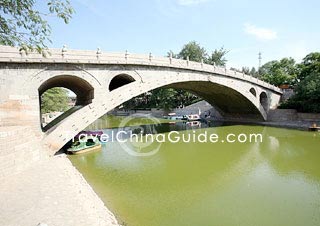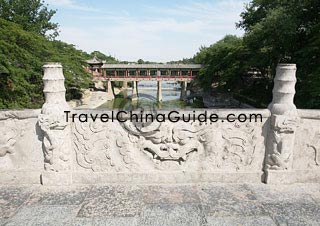Shijiazhuang Attractions - Things to Do
 |
| Zhaozhou Bridge |
Top Things to Do
Another provincial-level historical and cultural attraction is Zhao County, which boasts the famous Zhaozhou Bridge. This 1400 year-old stone bridge is located 45 kilometers (28 miles) southeast of the urban area of Shijiazhuang. It is quite an outstanding work in the history of China, and even world, bridge construction.
It is a small village in Pingshan County, which got the name Xibaipo, literally a slope with cypresses, from verdant cypresses on a hillside behind the village. It once served as the headquaters of the Central Committee of the Chinese Communist Party, Central Working Committee and Chinese People’s Liberation Army. 80 kilometers (49.7 miles) west of the downtown area, it echoes the splendid history of China's revolutionary movement. The residences and relics here enable visitors to get in touch with this aspect of China's history.
Zhengding County
Zhengding, a national-level historical and cultural county, is located 15 kilometers (9.3 miles) north of Shijiazhuang. In this two-thousand-year-old county, one must visit the majestic Longxing Temple, which houses the largest copper figure of the thousand-armed Avalokitesvara Bodhisattva in China and the elaborately designed statue of Vairocana Buddha. Moreover, the four pagodas (Mu Pagoda, Qing Pagoda, Hua Pagoda and Zhuan Pagoda) are also worth a visit for their various architecture styles.
Mt. Cangyan Scenic Area
 |
| Gazing from afar on Bridge |
Mt. Cangyan Scenic Area is renowned for its natural landscape and some cultural and historical attractions. It has verdant forests, magnificent waterfalls, crystal streams and springs, steep cliffs and queer peaks. Visitors should not miss the white sandalwood trees growing beside the mountain streams and about 2,000 to 3,000 years old cypresses on the cliffs.
Many temples, pavilions, terraces and other buildings are constructed on the cliffs or in the valley. Built in the Western Jin period (265-316), the Fuqing Temple is the most celebrated complex. Legend has it that Princess Nanyang once became a nun and practiced Buddhism there. She was the daughter of Yang Guang, an emperor of the Sui Dynasty (581-618).
The Fuqing Temple consists of the Dafo Hall, the Yuanjue Hall, the Lingguan Temple, the Guandi Temple, the Cangyan Tower, the Princess Memorial Hall, the Qiaolou and other structures. The Qiaolou (a hall built on the bridge) is the main structure of the Fuqing Temple. It is constructed on a single arch stone bridge which is about 15 meters (49 feet) long and nine meters (30 feet) wide. On the arch of the bridge are carved life size images of beasts, horses and human beings. The Qiaolou is a two storied building built in the Sui Dynasty and houses the statues of Sakyamuni and eighteen arhats and some murals.
The Princess Memorial Hall is situated to the north of the Qiaolou. In the hall stand the statue of Princess Nanyang with her two sisters attending to her. On the walls are painted some murals recording the stories of Princess Nanyang. Behind the hall is a cave which is said to be the princess' bedroom.
Catch a bus at the Xiwang Bus Station in Shijiazhuang to the Mt. Cangyan Scenic Area.
| Admission Fee: | CNY 50 |
| Opening Hours: | 09:00 to 16:00 |